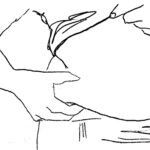I talk about contrast showers for boosting immunity, lowering inflammation, mood, pain and weight loss.
Hello everyone, my name is Dr. Talia Marcheggiani, I’m a naturopathic doctor and today I’m going to talk about hot and cold contrast showers. As naturopathic doctors, one of our modalities is hydrotherapy. Hydrotherapy comes from naturopathic medicine’s roots, using hot and cold water to make changes to circulation, hormonal functioning and immune functioning. I’m going to talk about some of the science behind hot and cold contrast showers.
This is something I recommend to my patients to increase their immune activation, decrease autoimmunity, improve mood and hormonal functioning, as well as increase circulation and there’s some evidence that it might help with weight loss as well.
So, firstly, things like exercise and hot and cold therapies induce a little bit of stress. There’s two kinds of stress: distress, which is sort of that chronic, cortisol-fuelled stress that a lot of people come in with, in a state of burnout that’s causing things like inflammation, and mental-emotional illness, and autoimmune issues, and dysbiosis, and then there’s something called eustress, which is more like exercise, cold therapy: short, small bursts of stress that actually up-regulate proteins and genes in our body to combat stress. These genes are involved in DNA repair, increase antioxidant synthesis, and the antioxidants that our body makes are far more powerful than the ones that you’re going to get from food or supplements.
So, by upregulating these genes, we can protect ourselves from cancer, neurodegenerative disease, and other chronic diseases. It’s really powerful stuff, this is called a “Hormetic” response, hormesis, where small stressors mount bigger responses by the body than is needed to deal with those stressors and overall we’re better off; there’s this net beneficial effect. This is one of the proposed mechanisms for some of the antioxidants or flavonoids in green leafy vegetables. It’s not that they provide us with antioxidants, it’s that they encourage our body to make antioxidants due to the small, toxic load that they present to us. And so there’s some evidence that getting short bursts, or longer bursts of cold, very cold, will increase a hormone called norepinephrine. Norepinephrine is involved in depression and mood. Norepinephrine is a catecholamine and it increases the sympathetic nervous system, which is that fight or flight nervous system. When boosted in small amounts, it can actually elevate mood and so a lot of anti-depressant medications also induce, or inhibit the reuptake of norepinephrine. So these are called SNRIs and they include things like Venlafaxine and Cymbalta. So there’s some evidence that norepinephrine increases 2-3 times after only 20 seconds of immersion in cold water. There’s a connection between norepinephrine lowering pain and inflammation and increasing metabolism and there’s some anecdotal evidence and one study, at least, was done to show that cold immersion therapy actually decreased symptoms of depression.
There’s also these things called hot and cold shock proteins, heat shock proteins and cold shock proteins. So, for example, one is called RBM3, which is a cold shock protein, and these proteins can actually help increase longevity and they can actually help decrease incidences of neurodegenerative diseases and neurodegeneration, so something like Alzeimer’s disease or Parkinson’s disease, which can help us with health longevity, so staying healthier into our later years.
We know that inflammation is one of the drivers of the aging process. Probably the primary driver of the aging process, and one of the main factors in chronic, debilitating disease, and, especially in my focus, mental health, there’s more and more researching coming out that inflammation, low levels of inflammation in the brain, is the main cause of mental health conditions, such as depression, and anxiety, bipolar disorder, OCD, ADHD. There’s these low levels of inflammation that contribute to the symptoms of low mood and by increasing norepinephrine, through small bursts of cold and increasing those cold shock proteins, we’re actually able to combat these mental health conditions. Norepinephrine decreases inflammation by decreasing a cytokine called TNF-a that is known to increase inflammation in the body and in the brain. TNF-a can cross the blood brain barrier and it can inhibit serotonin synthesis and it can actually also increase neuro-inflammation, causing symptoms of mental health disorders.
There’s some studies that cryotherapy, for rheumatoid arthritis actually decreased pain significantly. And there’s also some studies that being in cold water, that cold shock, can actually increase the immune system activation. It’s good to increase our immune system activation if our immune cells are behaving properly. If our immune cells are attacking ourselves, then we want to decrease the immune response. But having higher levels of lymphocytes, especially cytotoxic T lympthocytes that are involved in killing cancer cells, is a very positive thing and that’s been shown to increase in people that underwent cryotherapy, or really acute, short exposure to intense cold.
There’s also an ability to lose weight when exposed to cold, over the long term. There’s a man called Ray Cronise who lost over 80 lbs by just habitually exposing himself to mildly cold temperatures. And one of the mechanisms for this weight loss is through non-shivering thermogenesis, in which the cells in the mitochondria uncouple proteins that make energy and they dedicate all the stored energy in fat to making heat. Kind of like cutting your bike chain. So instead of biking, you’re not moving forward, but you’re generating energy and you’re generating heat. And so our body will do this when it’s slightly cold that it can increase heat. Our body is always striving to maintain constant temperature, between 1 or 2 degrees. This process is regulated by norepinephrine, which rises acutely as soon as we’re exposed to just a few seconds of cold. This can be 40-50 degree water. And then I already mentioned that short, cold exposure can increase the production of antioxidants. Our mitochondria are constantly creating reactive oxygen species and reactive nitrogen species. This is just a product of normal cell metabolism. These become toxic, though and damage DNA if our body doesn’t also produce anti-oxidants to clear out those reactive oxygen species and reactive nitrogen species. The cold induces a little bit of a stress that increases our metabolism that increases the reactive oxygen and nitrogen species in our mitochondria and therefore our body is incited to up-regulate the enzymes that create those powerful anti-oxidants that I talked about that are far more powerful than the ones that you can get from food: vegetables, fruits, vitamin C supplement. A couple of these enzymes are glutathione reductase and superoxide dismutase, which are very powerful to our cells.
There’s some evidence that hot and cold therapy can increase muscle mass, can increase muscular strength and aerobic endurance. So this is great for athletes post-workout to lower inflammation and improve muscle regensis. And then, it can also increase something called mitochondrial biogenesis, which is the production, or the replication of more mitochondria in the tissues, especially the muscle tissue. So our body will increase the mitochondria content, the mitochondrial mass, in muscle tissue under certain conditions. These conditions are mainly fasting, exercise, and hot and cold shock.
So, what I’ll recommend to my patients, somebody who’s suffering from low immunity, so they’re getting frequent colds and flus, or maybe autoimmunity, or maybe just general inflammation and pain, brain fog sluggishness adrenal fatigue, that kind of sluggish lethargy from depression. So it’s more the sluggish depression, I’ll recommend hot and cold showers.
So what you do is, in your shower, either during your shower, during your regular cleaning routine, or after your shower is done, and you’ve already washed your hair and everything, you’re going to turn the water on to a reasonably hot temperature, so not so hot that it’s scalding, and you’re going to leave that hot water on for 30 seconds to 1 minute. When that’s done, you’re going to turn the shower to as cold as you can tolerate. So with my patients I often coach them to start with a lukewarm temperature before going whole hog and doing cold. And this is just to coax the body into that stress response that we want, that short, quick stress response that’s going to do all those good things: up-regulate anti-oxidant production, increase norepinephrine, decrease inflammation, increase mitochondria synthesis, burn fat. So you’re going to try and make it as cold as possible, for 20 to 30 seconds, and then you’re going to cycle back and forth at least 5 to 10 times, always end on cold, and then, when you’re done, towel off and keep warm.
There’s some evidence that doing this before bed can actually increase REM sleep and help you sleep more soundly without waking up in the middle of the night. We all know that a good sound sleep is going to set the tone for the next day and your energy for the next day. And then there’s also some evidence that doing this in the morning can increase your energy and alertness throughout the day, so it’s almost like this same practice at different times of day impacts our circadian rhythms differently and can give us more of what we want: either more profound sleep or more daytime energy.
So, that was hot and cold showers, my name is Dr. Talia Marcheggiani and you can check out my website at taliand.com or contact me at connect@taliand.com . A lot of this research came from Dr. Rhonda Patrick at foundmyfitness.com .





